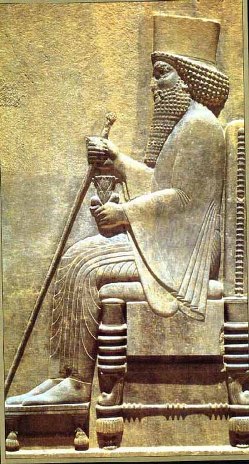Achaemenid Empire

At the beginning of the seventh century BC, the Persian tribes which had settled in fars formed a small state, under the leadership of king Achaemenes. His son, Teispes (675-640), extended the kingdom which, on his death, was divided between his successors: thus Ariaramnes became king of Parsa and Cyrus I king of Anshan. In 558 BC, Cyrus II the Great, a grandson of Cyrus I, was enthroned at Anshan.
Within a few years, he succeeded in conquering an immense empire that extended from Pakistan to the Mediterranean coast, first conquering Media, his former suzerain, then Lydia and the Greek colonies of lonia. In the east, he crossed the Oxus (Amu-Daria) and laxartes (Syr-Daria) rivers in Central Asia before following the Indus south. In 539, he conquered Babylon, entering the city as a liberator and sparing the population, a rare enough event in those times. This policy of tolerance and integration of the various peoples that made up his new empire was to characterize the reign of Cyrus. In 529, he died in battle and his elder son Cambyses II succeeded him.
Unlike his father, Cambyses (530-522 BC) ruled as a complete autocrat. After a victorious campaign against Egypt he annexed that country to his father’s empire, but during his absence the throne was usurped by the Magus Gaumata and the king died in mysterious circumstances in 522 BC.
The reign of the usurper lasted only a few months and he was executed by Darius I (522-486 BC), a descendant of Ariaramnes, who proclaimed himself the legitimate king. Despite the speed with which he overthrew Gaumata, it was to take the new ruler almost two years to establish his authority throughout the empire because of certain rebellious provincial rulers. He then began the reorganization of his vast empire, creating 23 provinces, or satrapies, and building the administrative and religious cities of Susa and Persepolis. His military campaigns extended the frontiers of the empire previously forged by Cyrus in the east, around 512 BC, he conquered Gandhara and the Indus Valley, while in the west, he attacked the Scythians, whom he never managed to subdue, and then turned against Greece. In 490 BC, came the humiliating defeat of Marathon, near Athens, which occurred while he was attempting to put down a rebellion in Egypt. Darius died in 486 BC without renewing his attack on Greece.
After the death of Darius the Immense empire established under the first Achaemenian rulers was threatened as Persian authority was no longer able to contain the rebellion Xerxes (486-465 BC) , the son of Darius, put down the revolts in Egypt and Babylonia with great severity and renewed the struggle against Greece. He quickly subdued Thessaly and Macedonia, then captured Attica and Athens, which he burned. Despite these successes, the Persian fleet was destroyed at Salamis in 480 BC. Discouraged, Xerxes returned to Persia, which he never left again. Gradually, the immense empire disintegrated; the Greek cities in lonia, Egypt, then Pheonicia and Syria broke away followed by the regions to the west of the Euphrates. Artaxerxes III (358-338) made one last attempt to reunify the empire, brutally taking back Egypt and quelling the revolt of the satraps, but a new power was already emerging in the west-Macedonia.
More about Achaemenian
Your feedback is extremely valuable to us, and will be useful for others.
So let us to have your comments.
.....
.....
.....

.jpg)



























